
Sharks are a group of elasmobranch fish characterized by a cartilaginous skeleton, five to seven gill slits on the sides of the head, and pectoral fins that are not fused to the head. Modern sharks are classified within the clade Selachimorpha and are the sister group to the Batoidea. Some sources extend the term "shark" as an informal category including extinct members of Chondrichthyes with a shark-like morphology, such as hybodonts. Shark-like chondrichthyans such as Cladoselache and Doliodus first appeared in the Devonian Period, though some fossilized chondrichthyan-like scales are as old as the Late Ordovician. The oldest confirmed modern sharks (selachimorphs) are known from the Early Jurassic, about 200 million years ago, though records of true sharks may extend back as far as the Permian.

The white-nosed coati, also known as the coatimundi, is a species of coati and a member of the family Procyonidae. Local Spanish names for the species include antoon, gato solo, pizote, and tejón, depending upon the region. It weighs about 4–6 kg (8.8–13.2 lb), and the nose-to-tail length of the species is about 110 cm (3.6 ft) with about half of that being the tail length. However, small females can weigh as little as 3.1 kg (6.8 lb), while large males can weigh as much as 9 kg (20 lb).
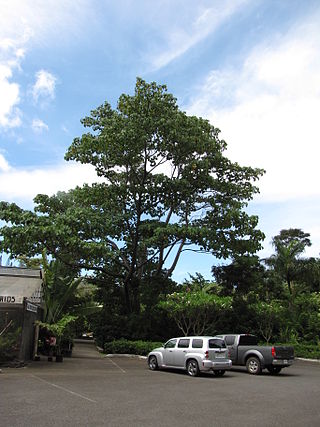
Ochroma pyramidale, commonly known as the balsa tree, is a large, fast-growing tree native to the Americas. It is the sole member of the genus Ochroma. The tree is famous for its wide usage in woodworking, due to its softness and its high strength compared to its low density. The name balsa is the Spanish word for "raft."
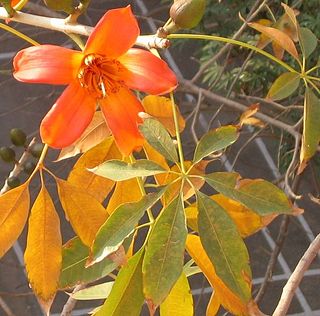
Bombax is a genus of mainly tropical trees in the mallow family. They are native to western Africa, the Indian subcontinent, Southeast Asia, and the subtropical regions of East Asia and northern Australia. It is distinguished from the genus Ceiba, which has whiter flowers.

Dracophyllum is a genus of plants belonging to the family Ericaceae, formerly Epacridaceae. There are 61 species in the genus, mostly shrubs, but also cushion plants and trees, found in New Zealand, Australia, Lord Howe Island and New Caledonia. The name Dracophyllum, meaning dragon-leaf, refers to their strong outward similarity to the unrelated Dracaena, sometimes known as dragon tree. Although dicotyledonous, they resemble primitive monocots with their slender leaves concentrated in clumps at the ends of the branches; they are sometimes called grass-trees.

The mangrove hummingbird is an Endangered species of hummingbird in the "emeralds", tribe Trochilini of subfamily Trochilinae. It is endemic to Costa Rica.

Ligustrum vulgare is a species of Ligustrum native to central and southern Europe, north Africa and southwestern Asia, from Ireland and southwestern Sweden south to Morocco, and east to Poland and northwestern Iran.

Ellobium pyramidale is a species of small, air-breathing, saltmarsh snail, a terrestrial pulmonate gastropod mollusk in the family Ellobiidae.
The Ichigkat Muja – Cordillera del Condor National Park is a protected area in Peru located in the region of Amazonas. It protects part of the Eastern Andes forests at the Cordillera del Condor mountain range.
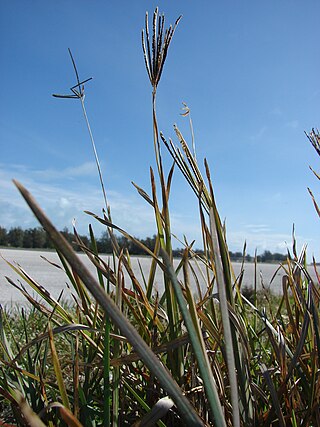
Eustachys is a genus of tropical and subtropical plants in the grass family. It is native primarily to warmer parts of the Americas, with a few species in Africa and Asia.
Aulosepalum is a genus of flowering plants from the orchid family, Orchidaceae. It consists of 8 species native to Mexico and Central America.
- Aulosepalum hemichrea(Lindl.) Garay - Oaxaca, Chiapas, El Salvador, Guatemala, Honduras, Nicaragua
- Aulosepalum nelsonii(Greenm.) Garay - Michoacán, Oaxaca
- Aulosepalum oestlundii(Burns-Bal.) Catling - Guerrero
- Aulosepalum pulchrum(Schltr.) Catling - Guatemala and southern Mexico
- Aulosepalum pyramidale(Lindl.) M.A.Dix & M.W.Dix - from central Mexico to Costa Rica
- Aulosepalum ramentaceum(Lindl.) Garay - Tamaulipas, San Luis Potosí
- Aulosepalum riodelayense(Burns-Bal.) Salazar - Oaxaca
- Aulosepalum tenuiflorum(Greenm.) Garay - Morelos, Guerrero

Goniophyllum is an Silurian genus of rugose coral known from Sweden, Norway, Canada, the United Kingdom and the United States. It is easily identified by its "lids" and distinct square shape. The genus was described by Milne-Edwards et Haime in 1851.
Animal Ethics is a nonprofit organization formed to promote discussion and debate around issues in animal ethics and to provide information and resources for animal advocates. They also do outreach work in several countries on the issue of speciesism. Their aim is to create a world where moral consideration is extended to all sentient beings. The organization's website covers topics such as speciesism, sentience, veganism and wild animal suffering and has content translated into several languages.
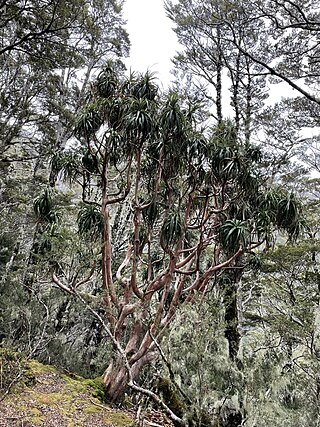
Dracophyllum traversii, commonly known as mountain neinei, grass tree, and pineapple tree is a species of flowering plant in the heath family Ericaceae. It is a deciduous tree endemic to New Zealand. It reaches a height of 0.2–13 m (0.66–42.65 ft) and has leaves which form tufts at the end of its branches. It has a lifespan of between 500 and 600 years.

Lophophytum is a genus of flowering plants belonging to the family Balanophoraceae.
Botryosporium is a genus of fungi belonging to the order Hypocreales, family unknown.
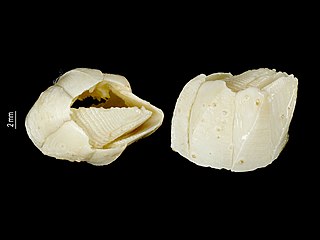
Pachylasmatidae is a family of symmetrical sessile barnacles in the order Balanomorpha. There are about 10 genera and at least 30 described species in Pachylasmatidae.

Eurylasma is a genus of symmetrical sessile barnacles in the family Pachylasmatidae. There are at least three described species in Eurylasma.














